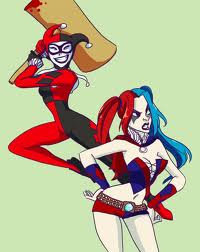Serendip is an independent site partnering with faculty at multiple colleges and universities around the world. Happy exploring!

From Harley Quinn to Marjane Satrapi: How Genre and Institutional Tropes Affect The Male and Female Gaze
In the summer of 2011, one of the world’s biggest comic distributors, DC, announced that it would be re-launching many of its most popular titles with new storylines and re-imagined characters. Superhero fans of all genders rejoiced until they saw the new titles and realized that many of DC’s female characters had been rendered flatter, more sexually appealing, and less dynamic than ever before. Female fans the world over began to press, at comic conventions and on the internet, for answers from DC as to why they had decided to leave 50% of the world’s population behind as they modernized their books. They were met with a variety of responses, many of which added up to a simple “We write for men.” Though this sentiment is nothing new, and female comic characters have always been rendered to suit the male gaze, it is problematic when taken in the context of a purported modernization and exceptionally problematic when one considers the extreme leaps in sexualization that many of DC’s female characters have endured in the context of the recent reboot.


Reflection on Technology and Social Media
After weeks of class and many interactions with media and technology, I now feel like I am in a position where I can really assess how technology is affecting (good and bad) my life.
Just from this class alone, my tech and computer literacy has sped up faster than I expected. Not only can I type super fast, navigate the world of touch screen, and balance multiple social/interactive websites, I can also think in very short, twitter-like sentences (I am not so sure that is a good thing). However, I am struggling in the sense that I do not know how to (or can't at all) balance between my "worlds," as lugones would say, in school, personal, and social/online life. In some ways it is uncomfortable to have the three merged because there is no sense of identity. Part of having an identity is knowing that there are distinct "sections" of myself and I feel like they have all become one, muddled pile. Is it at all possible to make clear distinctions between identities once tech and social media is involved? Do we have control over these distinctions now that sites, like Facebook, can be left to the viewer's interpretation?
Am I Colonized?
Thinking back again to the chapter on Childhood and Postcolonization, I can’t help, but think how waste is also an example of how colonization still exists in our society. When the United Sates does not know what to do with all of their “stuff,” they just send it off to the Third World as a free gift. Not only is this unsustainable, but it is also perpetuating the power dynamic between the United States and other continents such as Asian and Africa. It is also ironic that the cycle is actually a cycle. Clothing, electronics, products are made by sweatshop workers or modern day slaves in factories in China or by children in the Democratic Republic of Congo. These products are then sent to the United States and Europe where marketers manipulate consumers into buying useless products that they will eventually dispose of in exchange for more useless goods. The products they are “useless” are then taken to thrift stores and second hand stores, which only end up selling one fifth of that back into the economy and society. Finally the cycle goes full circle as the United States then ships all of this clothing and electronics to the countries that made the products in the first place. At some point, even these countries do not even need the products since there are so many excess products.

If she is an insider, what about me?

The feeling of reading Three Guineas seems a little bit awkward for me. Virginia Woolf asked many questions and answered them herself in the book, trying to make her writing more conversational and interactive. However I had a feeling of being excluded by the conversation. As a white woman from higher class, Virginia Woolf sent her invitations to the “outsiders”, yet I feel the ‘outside’ she defined is still the “inside” for most of us who read the book. With priorities of the rich, she could say that poverty, chastity, derision, and freedom from unreal loyalties are “four great teachers of the daughters of educated men”. However, does she really understand what the “outsiders” need and want?

Isn't exclusion necessary?
When we were talking about how Persepolis excludes many women, and only tells the story of one woman, I kept coming back to the idea that exclusion is necessary. Although feminism seeks to give voice to those who have been underheard, I don't think that works of literature can, or should try to show every side of the story or have every voice heard. Of course, it would be great if everyone's story were told through some medium, but individual works shouldn't have to do any more than tell one story. It's up to the reader to think about the other characters, such as the extremists in Iran, who we are not hearing from. I don't think that excluding an opinion makes something un-feminist. So many choices have to be made in the process of creating a story or work of art, that it seems ridiculous to say that feminism means hearing from the unheard, and therefore a text or peice is not feminist if it only gives one side to a story. A feminist person should try to hear all opinions, but it's too much to hold up each text and ask if it represents all sides of a story, although it is important to keep in mind who we are actually hearing from and not hearing from.

literal inscriptions
How does form inform our reading of texts as successfully feminist? (I am aware of my own biases in the meaning of “success,” but for the purposes of this exercise, I will define success as elliciting a response in those who engage with the material that incites emotion of some kind, in this case an emotional response that leads us to seek to support feminism). Typically feminsts forms have included poetry and literature, but these forms are somewhat tied to conceptions of women as delicate and admirers of that which is flowing, flowering, beautiful. Other options include co-opting the form of the patriarchal institutions which reinforce sexual hierarchies, such as academic work and dense theory couched in even denser language. This kind of feminism is far from accessible and has a specific class (and typically race) bias.



